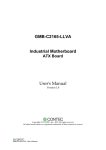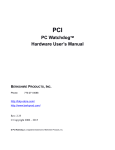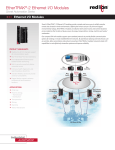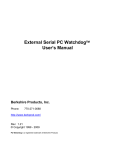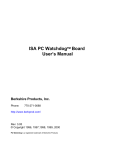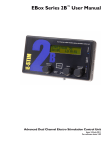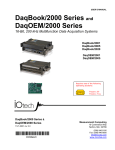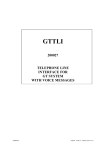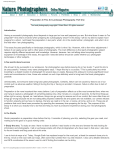Download PC Watchdog™ Hardware User`s Manual
Transcript
USB PC Watchdog Hardware User’s Manual Berkshire Products, Inc. Phone: 770-271-0088 http://www.berkprod.com/ Rev: 2.01 © Copyright 2001 - 2009 PC Watchdog is a registered trademark of Berkshire Products Table of Contents 1. INTRODUCTION...........................................................................................................................................1 2. OPERATION..................................................................................................................................................2 3. SUPPLIED COMPONENTS.........................................................................................................................3 3.1 INSTALLATION OF SUPPLIED COMPONENTS..............................................................................................................3 3.2 AUXILIARY RELAY ...............................................................................................................................................3 3.3 USB REV-B INTERNAL CONNECTION HEADER.......................................................................................................4 3.3.1 INTERNAL MOUNTING..........................................................................................................................................4 4. DIP SWITCH SETTINGS.............................................................................................................................5 4.1 4.2 4.3 4.4 4.5 4.6 4.7 MODE SWITCHES - SW1 & SW2.........................................................................................................................5 PASSIVE MODE - SW1.........................................................................................................................................5 ACTIVE MODE - SW2..........................................................................................................................................5 BUZZER DISABLE – SW3......................................................................................................................................5 OVER-TEMP RESET – SW4...................................................................................................................................6 POWER ON DELAY (POD) EXTEND – SW5.........................................................................................................6 SWITCH #6-8 - WATCHDOG DELAY TIME..............................................................................................................6 5. LEDS AND BUZZER ....................................................................................................................................7 5.1 D1 - LEDS.........................................................................................................................................................7 5.2 D2 – USB ACTIVE..............................................................................................................................................7 5.3 BUZZER................................................................................................................................................................7 6. WATCHDOG DRIVERS, PROGRAMS, AND API...................................................................................8 6.1 WEB SITE DOWNLOADS.......................................................................................................................................8 7. LOW-LEVEL PROGRAMMING INTERFACE........................................................................................9 8. LOW-LEVEL ACTIVE MODE OPERATION.........................................................................................10 8.1 8.2 8.3 8.4 COMMAND SUMMARY..........................................................................................................................................10 COMMAND: 0X02 – READ TEMP - RE-TRIGGER WATCHDOG.................................................................................12 COMMAND: 0X04 - GET STATUS INFORMATION....................................................................................................13 COMMAND: 0X08 - GET FIRMWARE VERSION NUMBER.........................................................................................14 i 8.5 COMMAND: 0X0C - GET DIP SWITCH SETTINGS...................................................................................................14 8.6 COMMANDS: 0X10 & 0X11 - READ / WRITE CURRENT ARM TIME.......................................................................15 8.7 COMMANDS: 0X14 & 0X15 - READ / SAVE NON-VOLATILE ARM TIME.................................................................16 8.8 COMMANDS: 0X18 & 0X19 - READ / WRITE CURRENT WATCHDOG TIME.............................................................17 8.9 COMMAND: 0X1A - READ HOLDING REGISTER WATCHDOG TIME.......................................................................18 8.10 COMMANDS: 0X1C & 0X1D - READ / SAVE NON-VOLATILE WATCHDOG TIME...................................................19 8.11 COMMAND: 0X20 - READ RE-TRIGGER COUNT...................................................................................................20 8.12 COMMAND: 0X30 – ENABLE / DISABLE WATCHDOG............................................................................................20 8.13 COMMANDS: 0X50 & 0X51 - READ / WRITE RELAY CONTROL ..........................................................................21 8.14 COMMANDS: 0X58 & 0X59 - READ / WRITE TEMPERATURE OFFSET...................................................................22 8.15 COMMANDS: 0X5C & 0X5D - READ / WRITE BUZZER CONTROL .......................................................................23 8.16 COMMAND: 0X80 - RESET PC..........................................................................................................................25 8.17 COMMAND: 0X84 - GET / CLEAR RESET COUNT................................................................................................26 8.18 COMMANDS: 0X88 & 0X89 - READ / WRITE RESET RELAY PULSE.....................................................................27 8.19 COMMANDS: 0XC0 & 0XC1 - READ / WRITE USER ID DATA............................................................................28 8.20 INVALID COMMANDS.........................................................................................................................................28 8.21 SPECIAL DIAGNOSTICS - 0XE0 TO 0XFF (DO NOT USE).....................................................................................28 9. APPENDIX A - SPECIFICATIONS...........................................................................................................29 10. APPENDIX B - WARRANTY...................................................................................................................30 11. APPENDIX C - SERVICE AND TECH SUPPORT................................................................................31 11.1 CALLING TECH SUPPORT...................................................................................................................................31 11.2 PRODUCT RETURNS...........................................................................................................................................31 12. APPENDIX D - AGENCY APPROVALS.................................................................................................32 12.1 FCC - CLASS A..............................................................................................................................................32 12.2 CE .................................................................................................................................................................32 i 1. Introduction The USB PC Watchdog is an internal device that is used to monitor a PC in order to ensure maximum system availability. It has the following features: • • • • • • • • • • • • • • • • Connects to USB port or a hub on a PC running Win98, ME, 2000, XP or Vista. Receives power from USB bus. Watchdog timer that can be set from 5 seconds to 1 hour via DIP switch or 1 second to 18 hours via software control. Monitors the PC USB bus for line activity in the passive mode. Can be used right from the box without any support programs. Has an on-board temp sensor to detect fan failures or other over-temp conditions. Two temperature trip points. Trip points can be modified by user software. Audible alarm for the temperature trip point. Programmable options allow the Watchdog to hold the PC in reset after the upper trip occurs. Also has an active Mode that allows a user program to have additional control over the Watchdog. Two externally visible LEDs show status of Watchdog. Watchdog has a second relay available on an external jack to control other devices such as triggering an alarm panel. Programmable power-on delay to allow the PC to complete its initialization sequence. Non-Volatile memory to store operating parameters. Eight bytes of non-volatile memory reserved for user data to implement simple software protection The latest versions of all manuals and sample code can be found on our site at: http://www.berkprod.com/ If you have any questions, corrections, or feedback about this manual please contact us at: [email protected] 1 2. Operation This device is designed to monitor PCs used in critical applications such as: File Servers, Voice Mail Systems, ISP systems, industrial applications, etc. The idea is to make sure the PC is always available and running; especially for systems that are not continuously monitored. When the PC is powered up, or after a reset of the PC,the PC Watchdog will wait a preset amount of time (2.5 minutes standard) to allow the PC to complete its reset and initialization sequence. This time will be referred to as Power-On-Delay (POD). After this time has expired, the PC Watchdog will Arm itself and start a watchdog timer running (user defined time-out period). There is a DIP Switch option to allow the Watchdog to extend this time for PCs that need additional re-boot time. Once the Watchdog is ready to arm itself it will check the DIP Switches and enable up to two independent operating modes. These modes can both be active at once. They are: • • Passive Mode – monitors the USB bus for a 32mS polling (interrupt) transaction. Please note that this mode is no longer recommended. Active Mode – requires that the host communicate with the board via direct communications on a regular basis. Additional DIP Switches are used to set the timeout period and temperature mode. If no activity is detected in Passive or Active Mode by the time the Watchdog timer expires, the PC Watchdog will start its reset sequence on the PC. The two LEDs on the Watchdog are used for status indication. The top LED provides the arming status of the Watchdog by varying the rate at which the LED flashes. When the Watchdog resets the PC it will turn on the bottom LED and leave it on which provides an indication that at least one Watchdog reset has occurred, possibly more. In Active Mode the PC can turn this LED off and also get a count of the number of resets that have occurred. The bottom LED will also flash (on or off) once per second for a tenth of a second if a Watchdog timer reset event occurred in the prior second. Note: If you stop your application program or you reset the PC with CTL-ALT-DEL, then be sure to disable the Watchdog by unplugging the reset cable or remove power by disconnecting he USB cable. Otherwise it may count down and reset your PC at an inopportune time! The temperature circuit on the board will monitor the internal temperature of the PC. There are two standard temperature trip points available: 46°C (115°) and 56°C (133°F). At the first trip point the PC Watchdog board will activate one of the relays if the option is selected. It will also activate an audible alarm and an external signal that is available on the DB-25 connector. At the second trip point the PC Watchdog can optionally pull a hard reset on the PC to stop further processing. There is an option to allow shifting the trip points higher via software control. The trip points can be increased in 1°C increments up to 77°C (171°F) and 87°C (189°F). 2 3. Supplied Components The standard Watchdog package contains the following items: • • • • The USB PC Watchdog timer on a standard PC I/O bracket. A USB interface cable. A CD-ROM. A reset cable 3.1 Installation of Supplied Components Perform these steps to install the Watchdog: • • • • • Locate an unused I/O slot in the PC. Remove the blank bracket and install the Watchdog. Make sure the Dip switches are set properly before applying power to the Watchdog since it only checks the switches at power up and after each reset of the PC. Disconnect the PC reset cable from the motherboard. Plug this cable onto the J5 (J4 on Rev-A) header labeled Reset SW in the upper left corner of the Watchdog board. Plug the supplied reset cable onto J4 (J3 on Rev-A) labeled CPU Reset on the Watchdog board and plug the other end onto the original reset header on the motherboard. Connect the USB cable to Host port on the PC or a port on a hub. Connect the other end of the cable to the Watchdog. The CD has a program to tickle the Watchdog without having to write any software. See the USB_v1_WDog_Tickle directory on the CD for a “tickle” program that can be setup to install automatically. 3.2 Auxiliary Relay There is a second set of relay contacts are on the 1/8" stereo jack on the bracket above the LEDs. The two relay contacts are on the inner two contacts of the jack (Tip & Ring). The sleeve of the jack is grounded through its connection to the bracket. This relay can be controlled by software. 3 3.3 USB Rev-B Internal Connection Header The new version of the board (Rev B) has a four (4) pin 0.100” single row header for USB connection to a USB header on a PC motherboard. This header is located directly behind the standard USB connector on the board. The pin out of the header is: + DD+ G 1 2 3 4 The enclosed cable with the four pin single row receptacle at each end is used to connect to the motherboard header. Pin 1 (+) should be the RED wire. The red wire should connect to the Plus (+) terminal on the motherboard header. NOTES: Do not reverse the cable – damage could be done to the Watchdog or the motherboard. Do not use the regular USB cable if using the motherboard header connection. 3.3.1 Internal Mounting The USB can be mounted internally by removing the standard PC bracket and using #4-40 hardware. There is a mechanical drawing file (MechanicalDrawing.PDF) on the CD which shows the dimensional information for the two holes on the board. 4 4. Dip Switch Settings All the switches are read at power up and after each time that the Watchdog resets the PC. A switch that is DOWN is OFF and a switch that is UP is ON. The following sections cover the switch options. Switch 1 2 3 4 5 6-8 Description Enable Passive Mode Enable Active Mode Disable Buzzer Temperature Reset Enable Power On Delay Watchdog Delay Time 4.1 Mode Switches - SW1 & SW2 These two switches set the operating mode of the Watchdog. If both of these switches are off then the Watchdog powers up in factory diagnostics mode and will not operate properly! It is OK for one or both of these switches to be on at one time. The Watchdog will support both modes together. 4.2 Passive Mode - SW1 When this mode is active the Watchdog will monitor the USB for a 32mS polling (interrupt) packet from the host PC. Each packet will cause the Watchdog to reset its timeout count. If the PC locks up and the packets stop then the Watchdog will count down to zero and reset the PC. We recommend that you no longer use this option. There is a program on the CD that will “tickle” the board in Active Mode. 4.3 Active Mode - SW2 If this switch is on the Watchdog enters command mode. This requires that the PC send commands to the Watchdog as USB data packets to make it reset the timeout counter. See the Command Mode section for further information. This mode will require the user to integrate support software into their application program. 4.4 Buzzer Disable – SW3 If this switch is on the buzzer will be disabled. The board must have firmware version 1.30 or higher for this switch option. 5 4.5 Over-temp Reset – SW4 If this switch is on then the Watchdog will reset and hold the reset on a PC during an over-temp condition. The first trip point is 46°C (115°F) at which point the buzzer will start to sound. The second trip point where the Watchdog can reset the PC is 56°C (133°F). If the Watchdog resets the PC, it will remain in reset until the temperature drops back below 50°C (122°F). There is a software option to allow shifting the trip points higher via software control. The trip points can be increased in 1°C increments up to 77°C (171°F) and 87°C (189°F). 4.6 Power On Delay (POD) Extend – SW5 After a power up or a PC reset the Watchdog normally waits 2.5 minutes to allow the PC to re-boot. This time can be shortened in software Command Mode. Sometimes the PC will require more than 2.5 minutes to complete the re-boot, which can be accommodated by turning on this switch. In Passive or Active Mode the Watchdog will delay starting the timeout counter until it "sees" the first activity in either of these modes. ** NOTE ** - Be Careful with this switch. If it is on and the PC locks up during reset then the board would not get “tickled” since no program would load. This would leave the PC permanently frozen. A better option is store a longer POD time in non-volatile memory. 4.7 Switch #6-8 - Watchdog Delay Time These switches set the delay time until the watchdog resets the PC. As long as the watchdog is receiving re-trigger pulses it will continue to reset the delay time. The settings and times are shown below: Switches 6-8 OFF-OFF-OFF OFF-OFF-ON OFF-ON-OFF OFF-ON-ON Delay Time 5 Seconds 10 Seconds 30 Seconds 1 Minutes Switches 6-8 ON-OFF-OFF ON-OFF-ON ON-ON-OFF ON-ON-ON These times can be overridden with other delays by a user program. 6 Delay Time 5 Minutes 10 Minutes 30 Minutes 1 Hour 5. LEDs and Buzzer 5.1 D1 - LEDs There are two LEDs on the back of the board. After the PC powers up the PC Watchdog will wait a programmed amount of time (set by the switch option) before it enters its watchdog mode. During this time the top LED will pulse at a 1 second rate (1 second on, 1 second off). When the PC Watchdog is ready and armed it will start flashing the top LED at a 300 milli-second rate as an indication that it is running OK. When the watchdog is within 4 seconds of resetting the PC it will flash this LED at a 1/10 second rate. If the watchdog board resets the PC, the top LED will return to its one-second toggle rate while it waits again for the PC to undergo a new reset sequence. When this occurs, the bottom LED will be forced on. This LED can be cleared by cycling power on the PC, pressing the front panel reset button, or by a user program. If the watchdog board is receiving re-triggers then it will flash the bottom LED for 100 milliseconds during each second. 5.2 D2 – USB Active This surface mount LED is located next to the USB socket on the board. This LED will flash rapidly when you first plug in the USB to indicate the enumeration process. After the device has been configured then this LED may flash to indicate USB activity. 5.3 Buzzer There is a buzzer installed on the board. When the first temperature trip occurs the buzzer will beep. When the second trip point occurs the buzzer will be on continuously. The buzzer will sound briefly when the board resets the PC and when the board powers up. If the board has a power up problem it will emit another long 1 second beep. 7 6. Watchdog Drivers, Programs, and API Please check the CD for recent updates in the readme.txt file. The PDF manuals are in the Manuals directory on the CD. The new DLL API and sample .cpp code is in the NEW_DLL_ConsoleTestAp directory on the CD. There is a new “C” Console Ap provided that shows how to interface with the new DLL. There is also a new VB .Net directory with sample code for using Visual Basic to access the board through the DLL. There is the older unsupported software on the CD for Win 98/ME/2000. 6.1 Web Site Downloads The latest versions of sample code, DLL, Documents, etc can be found on our site at: http://www.berkprod.com/ These downloads are ZIP files of the current CD image, Make sure you unzip them with the option to preserve directory structure. 8 7. Low-Level Programming Interface There is now a new DLL API (USB_v1_WDog.DLL) for interface and access to the board. It is recommended that all new users of this board stick with this API. The functions in this DLL are in the same format and are shared by the Ether-USB-PC-Watchdog and the PCI board. All the functions in the old DLL are included in the new DLL. This should make transition to the new DLL a little easier. The new DLL will work with Win 2K, XP, & Vista. Please see the USB_WDog_Int-ProgrammersManual.PDF on the CD for coverage of the functions in the new DLL. The older DLL and static library files are still on the CD. The old sample programs (Console Ap & VB6) programs are still there. The functions in the old DLL and LIB files only provide a low level interface to the board. The old DLL & LIB files support Win 95/98/2000/NT/XP. 9 8. Low-Level Active Mode Operation The Watchdog is designed to monitor the USB bus from the PC and respond to commands from the PC when the Active Mode is enabled. See the enclosed programs on the CD for sample code that you can use in your application program. Not recommended for new users. Use the new DLL on the CD. 8.1 Command Summary This tables summarizes the commands that can be sent: Command 0x02 0x04 0x08 0x0C 0x10 0x11 0x14 0x15 0x18 0x19 0x1A 0x1C 0x1D 0x20 0x30 0x50 0x51 0x58 0x59 0x5C 0x5D 0x80 0x84 0x88 0x89 0xC0 0xC1 Description Read Temp – Re-trigger Watchdog Get Status Information Get Firmware Version Get Dip Switch Settings Read Current ARM Time Write Current ARM Time Read Non-Volatile Arm Time Write Non-Volatile Arm Time Read Current Watchdog Time Write Current Watchdog Time Read Hold Register Watchdog Time Read Non-Volatile Watchdog Time Write Non-Volatile Watchdog Time Read Re-trigger Count Enable / Disable Watchdog Read Relay Control Write Relay Control Read Temperature Offset Write Temperature Offset Read Buzzer Control Write Buzzer Control Reset PC Get/Clear Reset Count Read Reset Relay Pulse Width Write Reset Relay Pulse Width Read User ID Data Write User ID Data NV VER No No No No No No No Yes No No No No Yes No No No Yes No Yes No Yes No No No Yes No Yes 1.00 1.00 1.00 1.00 1.00 1.00 1.00 1.00 1.00 1.00 1.45 1.00 1.00 1.00 1.00 1.351 1.351 1.00 1.00 1.40 1.40 1.00 1.00 1.00 1.00 1.00 1.00 Note 1: Commands 0x50 & 0x51 use bit fields. Some bits were added to firmware version 1.35. The NV column tells you if the command will write data to the non-volatile memory and thus will take longer to execute. Allow 100mS (milli-seconds) for the board to process a normal command and allow up to 200mS for a non-volatile memory write command. 10 The Version (VER) column tells you what firmware version your board should have to support the command. Items in bold type are new since last manual. The USB PC Watchdog uses a 6 byte report format. The board currently uses only 3 of the six bytes of the report. The report format in both directions is formatted as: Byte 0 CMD Byte 1 Data MSB Byte 2 Data LSB Byte 3 Not Used Byte 4 Not Used Byte 5 Not Used Do not use commands higher than 0xE0. They are for testing purposes only and will produce undesirable results. 11 8.2 Command: 0x02 – Read Temp - Re-trigger Watchdog This command will return the internal temperature of the PC and it also serves to re-trigger (“tickle”) the watchdog to reset the internal countdown timer. Send Command: BYTE 0 CMD 0x02 BYTE 1 MSB Not Used Byte 2 LSB Not Used BYTE 0 RESP 0x02 BYTE 1 MSB Not Used Byte 2 LSB Temp WDog Response: Notes: Returns the temperature data in degrees Celsius. The temperature readings are updated once per second. This is a signed value that can report temperatures less than zero. 12 8.3 Command: 0x04 - Get Status Information This command will return the status of the board. It is recommended that this command be used every once in a while. The non-volatile memory chip employs hardware circuits and software features to prevent inadvertent data corruption. However no method is always perfect. Send Command: BYTE 0 CMD 0x04 BYTE 1 MSB Not Used Byte 2 LSB Not Used BYTE 0 RESP 0x04 BYTE 1 MSB Not Used Byte 2 LSB Bits WDog Response: Notes: The response data byte is a bit field defined as: D0: Set to one (1) if non-volatile memory OK. If zero (0) then all data was cleared. D1: Set to one (1) if temperature sensor is OK. D2-4: Not used - will read as zero. D5: Set to one means the board is disabled by the disable command. Note: This status bit was added at Firmware Rev 1.45! Will read as zero (0) on older firmware. D6: Set to one (1) means the board has POD Extend switch on. The board has finished the POD time but is waiting for the first Temp read to “tickle” the watchdog. Note: This status bit was added at Firmware Rev 1.45! Will read as zero (0) on older firmware. D7: Set to one (1) when the board has completed its power-on delay and is armed. 13 8.4 Command: 0x08 - Get Firmware Version Number This command will return the numeric version of the firmware on the board. Send Command: BYTE 0 CMD 0x08 BYTE 1 MSB Not Used Byte 2 LSB Not Used BYTE 0 RESP 0x08 BYTE 1 MSB Whole# Byte 2 LSB Fraction WDog Response: Notes: The response data will be two bytes. The MSB is the whole number portion of the version and the LSB is the fraction. EX: 0x01 0x09 = Version 1.09 8.5 Command: 0x0C - Get Dip Switch Settings This command will return the setting of the Dip switch. The returned data is a byte (8 bits) for each switch with D0 representing SW8 through D7 for SW1. A switch that is ON will read as a one (1). Send Command: BYTE 0 CMD 0x0C BYTE 1 MSB Not Used Byte 2 LSB Not Used BYTE 0 RESP 0x0C BYTE 1 MSB Not Used Byte 2 LSB Bits WDog Response: 14 8.6 Commands: 0x10 & 0x11 - Read / Write Current Arm Time When you use the Watchdog for the first time it will wait 2.5 minutes, or it may use a programmed value, after a power-up or a reset before it arms itself. This allows the PC additional time to complete a reboot sequence. These commands allow you to check and shorten / lengthen the current delay. See the next section for storing a new wait time. Send Commands: BYTE 0 CMD 0x10 0x11 BYTE 1 MSB Not Used Delay Time Byte 2 LSB Not Used Delay Time BYTE 0 RESP 0x10 0x11 BYTE 1 MSB Delay Time Not Used Byte 2 LSB Delay Time Flag WDog Responses: Notes: The delay time sent can range from 0x0000 to 0xFFFF seconds. If the time is less than the current remaining wait time then the arming will occur sooner. The board will return a flag byte after a write operation. The flag will be zero if the board is already passed the power-on delay and is armed. This command is only active for the current session and the board will revert to its programmed delay at the next reboot. 15 8.7 Commands: 0x14 & 0x15 - Read / Save Non-Volatile Arm Time This command allows you to shorten or lengthen the delay after every reboot by saving the value in non-volatile memory. Send Commands: BYTE 0 CMD 0x14 0x15 BYTE 1 MSB Not Used Delay Time Byte 2 LSB Not Used Delay Time BYTE 0 RESP 0x14 0x15 BYTE 1 MSB Delay Time Not Used Byte 2 LSB Delay Time Not Used WDog Responses: Notes: If the time read is 0x0000 using command 0x14 then there is not a new Arm time in the nonvolatile memory. The new Arm time can range from 0x0001 to 0xFFFF seconds. If the value is set to zero (0x0000) on command 0x15 (write) then any Arm time in non-volatile memory will be erased and the board will go back to using the 2.5-minute delay. A non-zero value will be stored and then used as the Arm time on future resets and power-on. Be careful not to make it too short. 16 8.8 Commands: 0x18 & 0x19 - Read / Write Current Watchdog Time When you use the Watchdog for the first time it will use a countdown time set by the DIP switches (section 4.4) or it will use a stored value if programmed. This command allows you override the switch or stored setting to shorten or lengthen the delay. See the next section for storing a new delay time. Send Commands: BYTE 0 CMD 0x18 0x19 BYTE 1 MSB Not Used Delay Time Byte 2 LSB Not Used Delay Time BYTE 0 RESP 0x18 0x19 BYTE 1 MSB Delay Time Not Used Byte 2 LSB Delay Time Not Used WDog Responses: Notes: The delay time can range from 0x0001 to 0xFFFF seconds. A value of zero (0x0000) allows you to return to the time set on the DIP switch or the stored value in non-volatile memory if it exists. The new time will be activated at the next re-trigger of the Watchdog. A read will return 0xFFFF if the board is not yet armed. Be careful using low times (1 or 2 seconds) if your application runs as a low priority task. 17 8.9 Command: 0x1A - Read Holding Register Watchdog Time This command only works on boards with firmware version 1.45 or higher. The USB PC Watchdog uses an internal register to store the watchdog time that will be reloaded into the countdown timer every time the board it “tickled” Typically this value will be determined by the DIP Switch setting. It can be replaced by using the Write Current Watchdog Time (0x19 in the prior section) or it can be replaced with a value from the non-volatile memory which overrides the DIP Switch values at power up. Send Command: Port 6 CMD 0x1A Port 5 MSB Not Used Port 4 LSB Not Used Port 6 RESP 0x1A Port 5 MSB Hold Time Port 4 LSB Hold Time WDog Response: 18 8.10 Commands: 0x1C & 0x1D - Read / Save Non-Volatile Watchdog Time These commands allow you to check and shorten / lengthen the watchdog time for every reboot by saving the value in non-volatile memory. Send Commands: BYTE 0 CMD 0x1C 0x1D BYTE 1 MSB Not Used Delay Time Byte 2 LSB Not Used Delay Time BYTE 0 RESP 0x1C 0x1D BYTE 1 MSB Delay Time Not Used Byte 2 LSB Delay Time Not Used WDog Responses: Notes: If the time read is 0x0000 using command 0x1C then there is not a new watchdog time in the non-volatile memory. The new watchdog time can range from 0x0001 to 0xFFFF seconds. If the value is zero (0x0000) on command 0x1D then any watchdog time in non-volatile memory will be erased and the board will go back to using the DIP switch settings. A non-zero value will be stored and then used as the watchdog time on future resets and power-ups. The new time will also be activated next time the watchdog board is re-triggered. 19 8.11 Command: 0x20 - Read Re-trigger Count Every time the watchdog gets re-triggered by the re-trigger command (0x02) it will increment a 16 bit counter. This command allows you to read the counter. If you set the flags in the LSB to a non-zero value then the counter will be cleared after the value has been returned. Send Command: BYTE 0 CMD 0x20 BYTE 1 MSB Not Used Byte 2 LSB Flag BYTE 0 RESP 0x20 BYTE 1 MSB Count MSB Byte 2 LSB Count LSB WDog Response: 8.12 Command: 0x30 – Enable / Disable Watchdog When this command is received it will disable the watchdog if the MSB is 0xA5 and the LSB ix 0xC3. If you send any other values then the watchdog will be enabled. The flag returned will be non-zero if the watchdog is enabled. Send Command: BYTE 0 CMD 0x30 BYTE 1 MSB 0xA5 Byte 2 LSB 0xC3 BYTE 0 RESP 0x30 BYTE 1 MSB Not Used Byte 2 LSB Flag WDog Response: 20 8.13 Commands: 0x50 & 0x51 - Read / Write Relay Control This command provides a method to control the auxiliary relay on the board. You can also invert the operation of the relay at power-up and save the setting. When the relay is inverted it will be turned on within a few hundred milli-seconds of the PC being powered on. Send Commands: BYTE 0 CMD 0x50 0x51 BYTE 1 MSB Not Used Not Used Byte 2 LSB Not Used Bits BYTE 0 RESP 0x50 0x51 BYTE 1 MSB Not Used Not Used Byte 2 LSB Bits Bits WDog Responses: Notes: The data byte in the send command (0x51) is a bit field defined as: D0: D1: Set to one (1) to turn relay on. If set to one the auxiliary relay will pulse for the same length of time as the reset relay (see command 0x88). This option will be stored in non-volatile memory. D2: If set to one the auxiliary relay will latch on after the first watchdog reset and stay on. You can turn off the relay with bit D0. This option will be stored in non-volatile memory. D3-6: Not used - write zeros for future compatibility. D7: Set to one (1) to store relay inversion setting in non-volatile memory. Relay will turn on a few hundred milli-seconds after the PC powers up. This is only done at power-up. You can turn the relay off with bit D0. Setting bit D1 will also turn the relay off after the first watchdog reset. The data byte in the command response (0x50 or 0x51) is also a bit field defined as: D0: Set to one (1) means auxiliary relay is on. D1: Auxiliary relay set for pulse at watchdog reset. D2: Auxiliary relay set for latch on at watchdog reset. D3-6: Not used - read zeros for future compatibility. D7: Set to one (1) means non-volatile inversion setting is active. Note: Option bits D1 & D2 were added starting with firmware version 1.35. If D1 & D2 are both set then D2 will take priority. 21 8.14 Commands: 0x58 & 0x59 - Read / Write Temperature Offset This command allows you to increase the temperature trip points on the watchdog board. These commands allow you to set the offsets up to 31 (0x1f). If the offset is used then it will be active every time the PC powers up. Send Commands: BYTE 0 CMD 0x58 0x59 BYTE 1 MSB Not Used Not Used Byte 2 LSB Not Used Offset BYTE 0 RESP 0x58 0x59 BYTE 1 MSB Not Used Not Used Byte 2 LSB Offset Not Used WDog Responses: Notes: The offset here is in degrees C and can range from 0x00 to 0x1F. Values higher will be corrected modulo 32. A non-zero value is stored in the non-volatile memory. 22 8.15 Commands: 0x5C & 0x5D - Read / Write Buzzer Control This command provides a method to control the buzzer on the board. Normally the buzzer sounds at power up and after each reset of the PC. It only emits a beep that lasts about 600mS (0.6 seconds). This command provides additional control via bit field parameter. This command added at Version 1.50 firmware. Send Commands: Port 6 CMD 0x5C 0x5D Port 5 MSB Not Used Not Used Port 4 LSB Not Used Bits Port 6 RESP 0x5C 0x5D Port 5 MSB Not Used Not Used Port 4 LSB Bits Bits WDog Responses: Notes: The data byte in the send command (0x5D) is a bit field defined as: D0: D1: D2: D3: D4: D5: D6: D7: Set to one (1) for a 2.5 second beep after each reset (evaluated first). Set to one (1) for a continuous buzzer after the first reset. Note that this could be very annoying. Set to one (1) to turn on the buzzer. Method for user application to sound buzzer. Set to one (1) to turn off the buzzer (evaluated last). Also for a user ap to turn off the buzzer. Not used - write zeros for future compatibility. Not used - write zeros for future compatibility. Not used - write zeros for future compatibility. Set to one (1) to store in non-volatile memory the beep time set in D0 or D1. This will be effect every time the board powers up. If D0 and D1 are clear the non-volatile memory will be cleared. Bits are evaluated starting with D0 first. Example: if you set both D2 and D3 the result will be that the buzzer is off. 23 The data byte in the command response (0x5C or 0x5D) is also a bit field defined as: D0: D1: D2: D3: D4: D5: D6: D7: Set to one (1) means buzzer is/was set for 2.5 second beep. Set to one (1) means buzzer is/was set for continuous beep. Set to one means buzzer is/was on. Set to one means buzzer is/was off. Not used - read zeros for future compatibility. Not used - read zeros for future compatibility. Not used - read zeros for future compatibility. Set to one (1) means a non-volatile buzzer time setting is/was active. Using the read command (0x5C) will tell you what IS the current state. After using the write command (0x5D), the response will be what WAS the prior state before your new changes. 24 8.16 Command: 0x80 - Reset PC Use this command carefully. It will reset your PC. Send Command: BYTE 0 CMD 0x80 BYTE 1 MSB 0xA5 Byte 2 LSB Delay Time BYTE 0 RESP 0x80 BYTE 1 MSB Not Used Byte 2 LSB Flag WDog Response: Notes: If the delay time is set to zero the reset will occur immediately. The delay time can be as high as 255 (0xFF) seconds. If the board is not armed it will return a flag byte set to zero. In this case you will need to shorten the arm time to get the board armed. If the reset time is not zero and the board is armed then the flag will be non-zero. The MSB must be set to 0xA5 as a safety feature; if it is not 0xA5 then the flag returned will be zero. Once this command has been sent it cannot be disabled! The board will enter a mode where it will no longer communicate with the PC until the reset has been done. Even if the Watchdog board has been disabled via command 0x30, this command will still work! 25 8.17 Command: 0x84 - Get / Clear Reset Count When the watchdog board powers up it will set a counter to zero. Every time it resets the PC this count will increase by one. Use this command to get the count. If the Clear Flag is non-zero then the board will clear the count after it has been returned. If the count is cleared to zero then the bottom LED will also be turned off. Send Command: BYTE 0 CMD 0x84 BYTE 1 MSB Not Used Byte 2 LSB Clear Flag BYTE 0 RESP 0x84 BYTE 1 MSB Not Used Byte 2 LSB Count WDog Response: Notes: The count ranges from 0x00 to 0xFF (255). When the counter hits the upper limit it will stop rather than rollover. 26 8.18 Commands: 0x88 & 0x89 - Read / Write Reset Relay Pulse The default mode for the Watchdog is to pulse a reset relay (which simulates pushing the reset button) for 3 seconds. This value works for most computers, however some machines may require longer or shorter values. This command allows you to tailor the pulse time by selecting a delay in 50mS tics. Send Commands: BYTE 0 CMD 0x88 0x89 BYTE 1 MSB Not Used Not Used Byte 2 LSB Not Used Delay Tics BYTE 0 RESP 0x88 0x89 BYTE 1 MSB Not Used Not Used Byte 2 LSB Delay Tics Not Used WDog Responses: Notes: The delay time can range from 0x01 to 0xFF tics. A value of zero (0x00) allows you to return to the default 3 second pulse. The new time will be activated at the next re-boot of the PC and it will be stored in non-volatile memory. Be careful using low times (1 or 2 tics) since these may be too short to generate valid resets on the PC. 27 8.19 Commands: 0xC0 & 0xC1 - Read / Write User ID Data Eight (8) bytes of the non-volatile memory have been reserved for the user to store their own ID data. These bytes could have many uses with one of them being a software security mechanism. A user could make their software refuse to run unless there was a watchdog board in the system with the correct code in the memory. Send Commands: BYTE 0 CMD 0xC0 0xC1 BYTE 1 MSB Offset Offset Byte 2 LSB Not Used User Data BYTE 0 RESP 0xC0 0xC1 BYTE 1 MSB Not Used Not Used Byte 2 LSB NV Data Not Used WDog Responses: Notes: The offset should be a number between 0 and 7. Higher values will be corrected to modulo 8. Data can be any value from 0x00 to 0xFF. 8.20 Invalid Commands If you send a command is not implemented in the firmware on the board then the board will respond with zeros in all three response bytes. 8.21 Special Diagnostics - 0xE0 to 0xFF (Do Not Use) These commands are used for internal testing purposes. Do not use commands higher than 0xE0. They are for testing purposes only and will very likely produce undesirable results. 28 9. Appendix A - Specifications Power Requirements: +5 VDC - 60mA Max. Environmental: -20 - 65°C Operating -20 - 70°C Storage 5-95% Relative Humidity - Non Condensing MTBF: 500,000 Hours TEMP: ± 1.5°C Note: You may find that the board will continue to work just fine beyond the specified temperature limits, especially at lower temperatures. These temperature limits are those specified by the manufacturers of the integrated circuits. Auxiliary Relay #2: SPST (1 form a) - 48V @ 0.5A max This relay has contacts that are available on the 1/8" Stereo jack above the two LEDs. The tip of the plug is one relay contact and the ring (second terminal on the plug) is the other relay contact. The major or last conductor (sleeve) of the plug is ground and is connected to the PC bracket. 29 10. Appendix B - Warranty Berkshire Products, Inc. warrants to the original consumer or other end user purchaser that this product is free from defects in materials or workmanship for a period of one (1) year from the date of purchase. During the warranty period, and upon proof of purchase, the product will be repaired or replaced (with the same or functionally equivalent model) at our option, without charge for either parts or labor. This warranty does not apply to defects due directly or indirectly to misuse, abuse, negligence, accident, repairs or alterations made by the customer or another party. UNDER NO CIRCUMSTANCES WILL BERKSHIRE PRODUCTS, Inc. BE LIABLE IN ANY WAY TO ANY PURCHASER FOR DAMAGES, LOST REVENUE, LOST WAGES, OR ANY OTHER INCIDENTAL OR CONSEQUENTIAL DAMAGES ARISING OUT OF THE USE OR INABILITY TO USE THIS PRODUCT. Berkshire Products, Inc. reserves the right to make modifications in this product without prior notification. 30 11. Appendix C - Service and Tech Support We are available to help you with your questions and problems that you may have with our product. Our technical support is available: Monday through Friday (except holidays) 8:30 AM to 5:00 PM (Eastern Time) 770-271-0088 Email: [email protected] 11.1 Calling Tech Support To help our tech support personnel with your problem, please try to have the following information ready: • • • Type of PC Type of operating system and version Clear description of the problem 11.2 Product Returns Please call our tech support personnel before returning a product. Many times the problem can be corrected over the phone. If the tech support representative determines that your product must be returned, they will assign you a RMA #. Package the product in a secure container and return it to us freight prepaid. We will not accept COD freight charges! Indicate the RMA # on the package or shipping label. If the repairs are done under warranty the unit will be returned UPS ground and we will pay the freight charges. If you prefer Federal Express, please provide your Federal Express account number. If your unit is out of warranty, repairs and shipping will be charged COD or other method established in advance. 31 12. Appendix D - Agency Approvals The PC Watchdog meets the following agency approvals. 12.1 FCC - Class A This equipment generates and uses radio frequency energy and if not installed and used properly, that is in strict adherence with the manufacturer’s instructions, may cause interference to radio and television reception. It has been tested and found to comply with the limits for a Class A computing device in accordance with the specifications in Subpart J of Part 15 of FCC rules, which are designed to provide reasonable protection against such interference in a commercial installation. If this equipment does cause interference to radio or television reception, which can be determined by turning the equipment off and on, the user is encouraged to try to correct the interference by one or more of the following measures: • • • • • Reorient the receiving antenna. Relocate the computer with respect to the receiver. Move the computer away from the receiver. Plug the computer into a different outlet so that the computer and receiver are on different branch circuits. Consult the dealer or an experienced radio/TV technician for help. 12.2 CE The Internal Serial PC Watchdog has successfully passed all appropriate tests that are necessary for its certification under EMC directive 89/336/EEC. 32




































